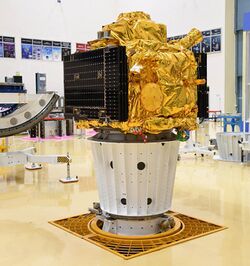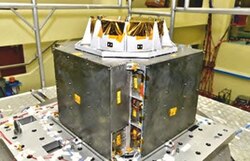Astronomy:XPoSat
 X-ray Polarimeter satellite (XPoSat) in deployed configuration | |
| Names | XPoSat |
|---|---|
| Mission type | Space observatory |
| Operator | ISRO |
| Website | www |
| Mission duration | Planned : 5 years Elapsed : 6 months, 17 days [1] |
| Spacecraft properties | |
| Spacecraft | X-ray Polarimeter Satellite |
| Bus | Modified IMS-2[2] |
| Manufacturer | Raman Research Institute U R Rao Satellite Centre |
| Launch mass | 480 kg (1,060 lb)[3] |
| Payload mass | 144 kg (317 lb)[3] |
| Dimensions | 65 × 65 × 60 cm (26 × 26 × 24 in) |
| Power | 1260 watts[3] |
| Start of mission | |
| Launch date | 1 January 2024, 9:10 AM IST (3:40 UTC) [4] |
| Rocket | PSLV-DL[5][6] |
| Launch site | Satish Dhawan Space Centre First Launch Pad |
| Contractor | ISRO |
| Orbital parameters | |
| Reference system | Geocentric orbit |
| Regime | Low Earth orbit |
| Perigee altitude | 638 km |
| Apogee altitude | 653 km |
| Inclination | 6°[3][7] |
| Period | 97.61 minutes |
| Instruments | |
| Polarimeter Instrument in X-rays (POLIX) X-ray Spectroscopy and Timing (XSPECT) | |
 XPoSat Logo | |
The X-ray Polarimeter Satellite (XPoSat) is an Indian Space Research Organisation (ISRO) manufactured space observatory to study polarisation of cosmic X-rays. It was launched on 1 January 2024 on a PSLV rocket,[8] and it has an expected operational lifespan of at least five years.[9][10]
The telescope was developed by the Raman Research Institute (RRI) in close collaboration with U R Rao Satellite Centre (URSC).[11] As per ISRO, this mission will complement the efforts of US space agency NASA, which launched its Imaging X-ray Polarimetry Explorer (IXPE) in 2021 by observing space events across a broad energy range of 2-30 keV.[12][13]
Overview
Studying how radiation is polarised gives away the nature of its source, including the strength and distribution of its magnetic fields and the nature of other radiation around it. XPoSat will study the 50 brightest known sources in the universe, including pulsars, black hole X-ray binaries, active galactic nuclei, neutron stars and non-thermal supernova remnants.[9][14] The observatory was placed in a circular low Earth orbit of 500–700 km (310–430 mi).[9][2] The payloads onboard XPoSat will observe the X-Ray sources during its transit through the Earth’s eclipse period.[15]
History
The XPoSat project began in September 2017 with Indian Space Research Organisation (ISRO) grant of ₹95,000,000. Preliminary Design Review (PDR) of the XPoSat including the POLIX payload was completed in September 2018, followed by preparation of POLIX Qualification Model and beginning of some of its Flight Model components fabrication.[16][17]
Launch
XPoSAT was successfully launched aboard PSLV-C58 on 1 January 2024 at 9:10 am IST. The launch was precise, leaving only a deviation of (±) 3 km. Following the launch, the final 4th stage of the PSLV dropped to a 350 x 350 km orbit to facilitate it's use as PSLV Orbital Experimental Module POEM-3.[18][19]
First Light
The XSPECT payload on XPoSat captured its first light from the Cassiopeia A (Cas A) a supernova remnant located over 11,000 light years away on 5th January 2024. During its performance verification phase, XSPECT was directed towards Cassiopeia A, a standard celestial source used for instrument evaluation which is among the brightest radio frequency source in the sky. The observation commenced on January 5, 2024, capturing the supernova remnant's emission lines corresponding to elements such as Magnesium, Silicon, Sulphur, Argon, Calcium, and Iron.[20][21]
Payloads
Two payloads of XPoSat are hosted on a modified IMS-2 satellite bus.[9] Primary scientific payload is Polarimeter Instrument in X-rays (POLIX), which will study the degree and angle of polarisation of about 50 brightest astronomical X-ray sources of different types during its mission in the energy range 8-30 keV.[2][22] POLIX, a 125 kg (276 lb) instrument,[9] was developed by the Raman Research Institute.[14][2][22][23]
Polarimeter Instrument in X-rays (POLIX)
POLIX is the primary scientific payload aboard XPoSat. It is a Thomson X-ray polarimeter, which measures the degree and angle of polarization (polarimetry parameters) of astronomical sources in the medium X-ray range (8-30 keV).[24] It has been developed by Raman Research Institute.
Its science objectives are to measure:[23]
- the strength and the distribution of magnetic field in the sources
- geometric anisotropies in the sources
- their alignment with respect to the line of sight
- the nature of the accelerator responsible for energising the electrons taking part in radiation and scattering.
The experiment configuration consists of a collimator, central low Z (lithium, lithium hydride or beryllium) scatterer surrounded by xenon filled four X-ray proportional counters as X-ray detectors which collects the scattered X-ray photons.[11] The instrument is rotated along the viewing axis leading to the measurement of the azimuthal distribution of the scattered X-ray photons which gives information on polarisation. Polarised X-rays will produce an azimuthal modulation in the count rate as opposed to uniform azimuthal distribution of count rate for unpolarised X-rays. POLIX has four independent detectors, each with its own front end and processing electronics. Localization of the X-ray photon in the detectors is carried out by the method of charge division in a set of resistive anode wires connected in series.
The prime objects for observation with this instrument are the X-ray bright accretion powered neutron stars, accreting black holes in different spectral states, rotation powered pulsars, magnetars, and active galactic nuclei. This instrument bridges an energy gap in detection capability, between the soft X-ray polarimeters utilising Bragg reflection (OSO-8) or Photoelectron tracks (IXPE), and hard X-ray polarimeters using Compton scattering such as the Cadmium Zinc Telluride Imager (CZTI) on AstroSat.
X-ray Spectroscopy and Timing (XSPECT)
XSPECT is the secondary payload on XPoSat. It measures spectroscopic information, timing of soft X-rays and electromagnetic spectrum generated by different types of matter.[25][12] XSPECT is designed to pursue timing studies of soft X-rays (0.8-15 keV),[24] complementary to what the Large Area X-ray Proportional Counter (LAXPC) does at high energies on AstroSat, while simultaneously providing adequate spectral resolution in the 1-20 keV band. It has an energy resolution of <200 eV at 5.9 keV (-20 °C) and a timing resolution of ~2 msec. It has been developed by the Space Astronomy Group of the U R Rao Satellite Centre.
The detector achieves modest effective area without the use of focusing optics using the large area Swept Charge Devices (SCD), a variant of X-ray charge-coupled Devices (CCDs). SCDs permit fast readouts (10–100 kHz) and moderately good spectral resolution at the cost of a position sensitivity. These devices are unique in requiring very benign cooling requirement (requiring only passive cooling) unlike traditional X-ray CCDs.
Key science objectives of XSPECT include understanding long-term behavior of X-ray sources through correlation of timing characteristics with spectral state changes and emission line variations.
See also
- Imaging X-ray Polarimetry Explorer
- List of X-ray space telescopes
- X-ray astronomy satellite
- X-ray telescope
References
- ↑ Dutt, Anonna (21 December 2023). "ISRO to usher in New Year with XPoSat launch". The Indian Express. https://indianexpress.com/article/india/isro-new-year-xposat-launch-9078150/.
- ↑ 2.0 2.1 2.2 2.3 "ISRO announces Seven Mega Missions". 20 May 2019. https://currentaffairs.gktoday.in/isro-announces-mega-missions-05201968993.html.
- ↑ 3.0 3.1 3.2 3.3 XPoSat User Meet. 25 May 2023. Event occurs at 1 hour 5 minutes 34 seconds.
- ↑ Mandal, Annu (22 December 2023). "ISRO to launch of XPoSat mission on January 1, 2024, to study polarisation along with NASA". Financial Express. https://www.financialexpress.com/life/science-isro-to-launch-of-xposat-mission-on-january-1-2024-to-study-polarisation-along-with-nasa-bkg-3345157/.
- ↑ Volosín, Juan I. Morales. "XPoSat : PSLV-DL". https://everydayastronaut.com/xposat-pslv-dl/.
- ↑ "ISRO to study black holes; launch of X-Ray Polarimeter Satellite today" (in en). mint. 31 December 2023. https://www.livemint.com/science/isro-to-study-black-holes-launch-of-x-ray-polarimeter-satellite-on-1-jan-heres-all-you-need-to-know-11704003125974.html.
- ↑ Kumar, Chethan (30 November 2023). "XPoSat set to revolutionize x-ray astronomy: Isro". TNN. The Times of India. https://timesofindia.indiatimes.com/home/science/xposat-set-to-revolutionize-x-ray-astronomy-isro/articleshow/105610104.cms?from=mdr.
- ↑ Nigam, Saumya (2023-12-26). "ISRO to launch PSLV-C58 with XPoSAT on January 1 to study black holes, neutron stars | Details" (in en). https://www.indiatvnews.com/science/isro-to-launch-pslv-c58-with-xposat-on-january-1-to-study-black-holes-neutron-stars-details-2023-12-26-909050.
- ↑ 9.0 9.1 9.2 9.3 9.4 "Future Exploration Missions of ISRO". Dr. M. Annadurai, Director, ISAC, ISRO. UNCOPUOS 60th Session, Vienna, 2019. ISRO. http://www.unoosa.org/documents/pdf/copuos/2017/copuos2017tech30E.pdf.
- ↑ "Loksabha Q&A". DEPARTMENT OF SPACE. 2023-04-05. https://pqals.nic.in/annex/1711/AU5386.pdf.
- ↑ 11.0 11.1 "Isro to illuminate cosmic mysteries of black holes with launch of XPoSat mission" (in en). 2023-12-06. https://www.indiatoday.in/science/story/isro-xposat-mission-pslv-launch-x-ray-polarisation-black-hole-neutron-stars-2472657-2023-12-06.
- ↑ 12.0 12.1 Mandal, Annu (2023-12-22). "ISRO to launch of XPoSat mission on January 1, 2024, to study polarisation along with NASA" (in en). https://www.financialexpress.com/life/science-isro-to-launch-of-xposat-mission-on-january-1-2024-to-study-polarisation-along-with-nasa-bkg-3345157/.
- ↑ Kumar, Chethan (2023-11-30). "XPoSat set to revolutionize x-ray astronomy: Isro". The Times of India. ISSN 0971-8257. https://timesofindia.indiatimes.com/home/science/xposat-set-to-revolutionize-x-ray-astronomy-isro/articleshow/105610104.cms?from=mdr.
- ↑ 14.0 14.1 "5 Unique Space Science Missions That ISRO Will Be Flying in the Near Future". https://thewire.in/the-sciences/space-science-aditya-isro-xposat-nisar.
- ↑ "India set to launch its first X-Ray Polarimeter Satellite: ISRO" (in en-IN). The Hindu. 2023-11-30. ISSN 0971-751X. https://www.thehindu.com/sci-tech/science/india-set-to-launch-its-first-x-ray-polarimeter-satellite-isro/article67589615.ece.
- ↑ "XPoSat". https://www.isro.gov.in/XPoSat.html.
- ↑ "Raman Research Institute, Annual Report 2018-19". http://www.rri.res.in/htmls/gen/RRI2019annualreport_english.pdf.
- ↑ "New Year's Day Launch,The XPoSAT mission by ISRO" (in en). https://www.brutimes.com/news/india/new-years-day-launchthe-xposat-mission-by-isro.
- ↑ (in en) Launch of PSLV-C58/XPoSat Mission from Satish Dhawan Space Centre (SDSC) SHAR, Sriharikota, https://www.youtube.com/watch?v=H10igyNHsr4, retrieved 2024-01-01
- ↑ "XSPECT payload performance verified with Cas A observation". 11 January 2024. https://www.isro.gov.in/XSPECT_payload_performance.html.
- ↑ "ISRO Payload "Aces" Performance Check, Captures Light From Supernova Event". 11 January 2024. https://www.ndtv.com/science/isro-payload-aces-performance-check-captures-light-from-supernova-event-4842800.
- ↑ 22.0 22.1 "Chandrayaan 2 launched: Here are future ISRO missions to space". 2019-07-22. https://indianexpress.com/article/technology/science/chandrayaan-2-launched-here-are-future-isro-missions-to-space-5842337/.
- ↑ 23.0 23.1 X-ray Polarimeter Experiment (POLIX) Raman Research Institute Accessed on 2 August 2019
- ↑ 24.0 24.1 Ghosh, Sahana (11 September 2023). "India to launch world’s second X-ray polarimetry space observatory" (in en). Nature India. doi:10.1038/d44151-023-00132-x. https://www.nature.com/articles/d44151-023-00132-x.
- ↑ "Government of India, Department of Space, Annual Report 2020". https://www.isro.gov.in/sites/default/files/flipping_book/annual_report_2019-20_english/files/assets/common/downloads/Annual%20Report%202019-20%20%28English%29.pdf.
 |





